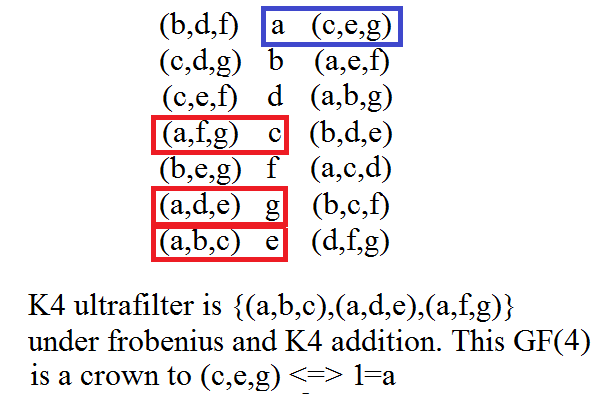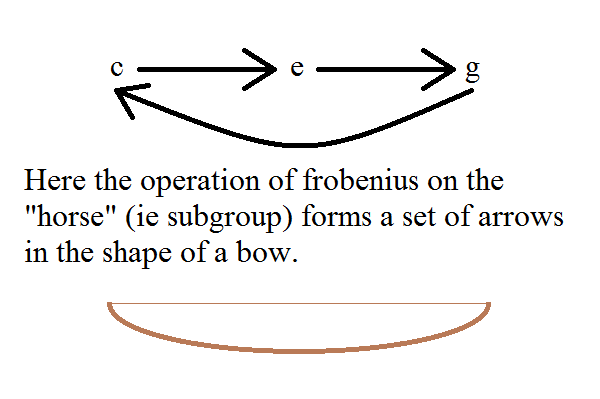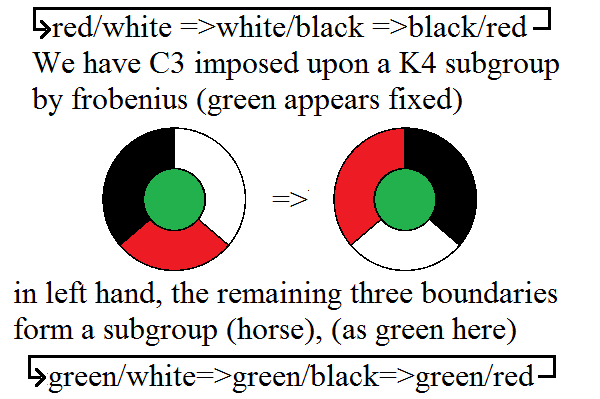Revelation
|
 The Seals - Shifting Identity
We know that in any particular octal in seven symbols (as well as a zero for the identity) we may arbitrarily choose which element is to be unity in the multiplicative group of C7. However when we fix the octal group and change identity elements amongst the seven we have a division of four subgroups which preserve a static subgroup, and then a further three choices (the elements in the static subgroup) that have no such preservation of the finite field structure of GF(8).
The first four choices of identity elements associate with the four horsemen of the first four seals and then the latter three align with the "hail" of the right hand subgroups, not the reversed direction that aligns as "fire" with the lamps of the Holy Spirit (the seven cycle). This seems strange, that in the subgroup K4 (of the octal) that is static should be identified with those elements in Christ as "cold" but it turns out that this is the very condition we find in the later sixth trumpet, which is the spirit of Death that is overcome by Christ - which shows only He is worthy to open the scroll with seven seals - that Jesus Christ is the resurrection and the life. (And is also God Himself.)
So starting with our right handed octal in its subgroups on the left, we can associate any identity element from the complement of the groups elements. I.e., we may associate the subgroup (a,b,c) held static with those elements {d,e,f,g} as unity. We may in fact do this the opposite way around and associate an identity from the octal with four choices of subgroups - but we shall leave this for later in the trumpets. For now, we are principally concerned with the colour coding of the horses.
-- Click To Expand/Collapse Bible Verses -- Rev ch6:v1-8
Rev 6:1 And I saw when the Lamb opened one of the seals, and I heard, as it were the noise of thunder, one of the four beasts saying, Come and see.
Rev 6:2 And I saw, and behold a white horse: and he that sat on him had a bow; and a crown was given unto him: and he went forth conquering, and to conquer.
Rev 6:3 And when he had opened the second seal, I heard the second beast say, Come and see.
Rev 6:4 And there went out another horse that was red: and power was given to him that sat thereon to take peace from the earth, and that they should kill one another: and there was given unto him a great sword.
Rev 6:5 And when he had opened the third seal, I heard the third beast say, Come and see. And I beheld, and lo a black horse; and he that sat on him had a pair of balances in his hand.
Rev 6:6 And I heard a voice in the midst of the four beasts say, A measure of wheat for a penny, and three measures of barley for a penny; and see thou hurt not the oil and the wine.
Rev 6:7 And when he had opened the fourth seal, I heard the voice of the fourth beast say, Come and see.
Rev 6:8 And I looked, and behold a pale horse: and his name that sat on him was Death, and Hell followed with him. And power was given unto them over the fourth part of the earth, to kill with sword, and with hunger, and with death, and with the beasts of the earth.
(KJV)
Things to notice:
1) John is called over
to each of the beasts, The horse and its rider in each case is seen
within the beast itself, exactly where they are 'full of eyes within'.
2) In verse 2, The rider has a bow. In fact, the bow in strong's is defined "as the simplest
fabric." It is a bow as one would imagine in a longbow, not a shoelace or
simply the type on a package or present.
3) Verse 4) who
is the they in "that they should kill one another"? Are the first and
second riders set against each other? Why is the sword "given" unlike the bow or the balances? (Is the sword required for something special?)
4) Verse 5, 6) The balances are used in the dialogue process to reconcile the first two horsemen to each other - the resolution of conflict by method of the dialectic, thesis + antithesis = synthesis.
5) Verse 8) Pale has been translated as green, or
speckled. Why the colours anyway?
We have seen that a group of K4 subgroups in the octal can be as a field GF(4) - an ultrafilter under the action of frobenius upon that group. If a = 1 and (b,d,f) is held static then we may form our left and right hands upon those elements of the static group only, and without loss of generality we have both the left and right hands as a field isomorphic to GF(4). Thus on the right and on the left we have some sense of equality, as "crown". It is this crown on the left hand that we associate with the rider on the white horse. By "horse" we mean the subgroup in the left hand (In our case (c,e,g) if a=1 and (b,d,f) is fixed.)

Addendum:
The term "horse"
applies as it were to K4 subgroups of the octal. Each such subgroup has four elements (legs upon the horse) one of which is zero, (as lifted off the ground in appearance to John) The multiplication table for the K4 group shows that the elements permute each other so that in each "position" or under multiplication by each element, one leg is always off the ground. The horse may be considered to have "a rider" which is sat on the horse. In fact, the rider is the "unity element" of GF(8) though any element of the octal outside of the K4 subgroup will suffice: With the K4 subgroup G, and the rider x, we have the coset x+G which is in view here. (x is "acting upon" or "sat upon" G.) We also see in the seals that the rider is as the unity element of the octal and is then "at rest" whilst sat upon (riding) the horse.
What is meant by the rider "has a bow"? (or as of the simplest fabric)? Well we see how (b,d,f) is fixed under frobenius,.. Likewise the complement subgroup in the left hand is also fixed, (though the operations are not the same as in the right hand.

Here we see "what John was shown", and it is indeed of the simplest fabric, (even the arrows!).
So, why the colour white? - or of red or black or pale?
It is a fact that any " cartographic or plane map" requires four colours so that any two neighbouring countries on the map may be different colours whilst not requiring more than four colours for the whole globe. The borders of regions therefore can be considered as a "red/white" boundary, or "black/green" etc. if we have labels for colours {a,b,c,d} then we may use addition modulo 2 to form a group as the octal. (Referring to the colour changes across borders).
(0,a+b,a+c,a+d,b+c,b+d,c+d,a+b+c+d) or simply (0,ab,ac,ad,bc,bd,cd,abcd)
If we use our ultrafilter we can make unity; 1 = abcd, consequently we choose (ab,ac,bc) static as under frobenius (the subgroup in the right) and (ad,bd,cd) as also fixed, our "bow" for the white horse. Then "d" becomes our colour of the horse... The horse is not a "subgroup" per se,.. but in the left hand is in alignment with a subgroup of the right.
We see that the terms "crown" and "horse" are indeed used in a similar fashion to those used in the vision John had of the fifth trumpet locusts and the horsemen in the sixth trumpet.
So the colours across borders can be thought of as being permuted under frobenius on GF(8). In fact they preserve four colour maps "colouring properties" rather than the individual colours. For instance - consider the simplest four colour graph here, with the "green" horse.

Here, choose a boundary, apply the frobenius map and to the same boundary note the result in the field GF(8) and reapply the result to the same place in the map. Thus in place, white/red goes to black/white etc..
I have chosen the colours to suit. It makes more sense to place this simple map on a sphere or as the faces of a tetrahedron. In that sense we understand the first four seals to be of the four horsemen of a different "colour"
The first horse is alike Christ (appears to have a similar crown) but is in the left hand. Truthfully that is as close as it gets. The left hand elements at this point are merely sets of three elements that are "static" in triples. There is not to be assumed an operation within those sets alike to that of K4, but that we have seven associations of three element sets in the left hand, one to each right hand singleton element.
We see then that He is "anti" - Christ. (anti meaning both "in place of" and "against"). He is said to go forth conquering and to conquer. This could be relevant to two things, either on the sphere/tetrahedron as above we show that the green horse is both "surrounding" the other three "regions" or that the "bow" of the horsemen (ad,bd,cd), the edges of the green region point outwards, as if he were about to conquer, or to go out conquering.
Addendum
With the immediate release of restraint from heaven of those in Christ (as the static K4 subgroup) to the antichrist "bow", it occurs that under every seven cycle the remaining associations in the same octal between static subgroup and "bow" and unity are completely determined by each seven cycle. Without needing or including a left handed octal the rider of the horse goes out "conquering and to conquer" every set of four "earthy elements" in the four beasts, (presumably each of the four possible bows by shifting the loosed unity element element to conquer the "fourth part of the earth"). With the loosing of restraint by the opening of the first seal upon the "church", antichrist freely rides out conquering all those outside of Christ. (Those whom are ungodly and also those that believe yet diminish the completed work of Christ are now "concluded in their unbelief as antichrists".)
The other possibility is that because this is antichrist, (and in a spiritual sense) there is an antichrist spirit that is made manifest as a subtle replacement of the true Christ. Then he is "permitted" to conquer by God, and overcome the saints as the book of revelation describes.
There is also the fact from the text that only Jesus could open the seals, and there was found none other that could accomplish it. We identify Jesus with the one "walking through the candlesticks" - the static triple under frobenius that is also a K4 subgroup.
Given a static subgroup G = {0, x, x2, x2+x} (static under frobenius when the irreducible over GF(2) is x3+x+1=0) We see easily that unity is in the coset and not in the group.
Likewise of the remaining subgroups acted upon by x, we have
xG = {0, x2, x+1, x2+x+1} likewise not containing unity
and also, x2G = {0, x+1, x2+x, x2+1} also without unity
and finally, x4G = {0, x2+x+1, x2+1, x} without unity.
Since all the other K4 subgroups contain unity, they may not represent static subgroups. Thus, the elements of the seven cycle x, x2, x4 are static under frobenius and thus the seals (which in truth correspond to a floating unity) must require these same three elements of the seven cycle to open them.
The seven cycle in "x" above is isomorphic to the Field GF(8) (i.e. under the same octal) in the symbols a to g with unity shifted (floating): The result is that the additive elements appear relabelled amongst themselves to give the appearance of a floating unity: Yet in reality the elements in powers n=1, 2 or 4 of x (held static under frobenius) are used to move the unity element from one element of the coset to another by multiplication: The result is that the group xnG is of "a different colour", ie, {rb, bw, rw}as green becomes {rg, gw, rw} as black etc. and that is which was what was wanted. (Yet the isomorphism of the field GF(8) is preserved within the polynomials in "x".)
The elements x, x2, x4 are the very elements in G = {0, x, x2, x2+x}, which is the same static K4 subgroup representing the lion of Judah, as it were the "lamb before the throne" without the "two parts cut off" from GF(4), but instead with Christ sat "at the right hand".
Continue To Next Page
Return To Section Start |